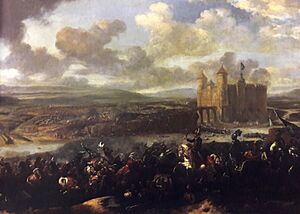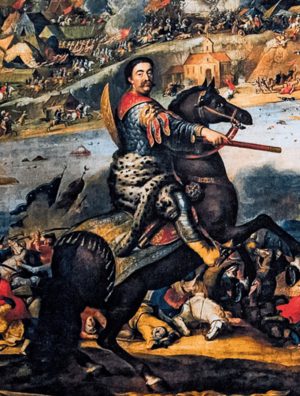Battle of Khotyn (1673) facts for kids
Quick facts for kids Battle of Khotyn |
|||||||
|---|---|---|---|---|---|---|---|
| Part of the Polish–Ottoman War (1672–1676) | |||||||
 Battle of Khotyn in 1673 by Jan van Huchtenburg (c. 1675) |
|||||||
|
|||||||
| Belligerents | |||||||
| Commanders and leaders | |||||||
| Strength | |||||||
| 29,000–30,000 | 35,000 | ||||||
| Casualties and losses | |||||||
| 2,000 killed and wounded | 20,000–30,000 killed and wounded | ||||||
The Battle of Khotyn was a major fight that happened on November 11, 1673. It took place in a town called Khotyn. In this battle, the army of the Polish–Lithuanian Commonwealth fought against the forces of the Ottoman Empire.
The Polish-Lithuanian army was led by a famous commander named John Sobieski. He was a Grand Hetman, which was a top military leader. The Ottoman forces were led by Husein Pasha. This battle was important because it changed how the war was going. The year before, the Commonwealth had been weak and signed a difficult peace treaty. This victory helped John Sobieski become the next King of Poland.
Contents
What's in a Name?
The town of Khotyn has been controlled by many different countries over time. Because of this, its name has changed a lot. You might also see it called Chocim (in Polish) or Hotin. These different names all refer to the same historic place.
The Battle of Khotyn: A Winter Fight
The Polish-Lithuanian army, with about 30,000 soldiers, arrived at the Khotyn fortress in early November 1673. The fortress was in a strong natural spot, surrounded by a bend in the Dniester River. Earth walls and other defenses protected it from the land side.
Preparing for the Attack
On November 10, John Sobieski's troops made small attacks. These were not the main fight. Instead, they were meant to check out the enemy's positions. Sobieski wanted to see where the Ottoman forces were placed. He also noticed that the weather was getting very cold. The Ottoman soldiers were not ready for such freezing conditions. They were tired from the cold and lack of sleep.
The Main Attack Begins
The Polish-Lithuanian army kept up small attacks all night. The wind was strong, and the cold was terrible for the Ottoman troops. At dawn on November 11, Sobieski personally led his soldiers to storm the Ottoman camp.
First, cannons fired loudly. Then, the infantry (foot soldiers) and dragoons (soldiers who rode horses but fought on foot) charged forward. They pushed back the Ottoman defenders from their walls. This made a path for the cavalry (soldiers on horseback).
The Hussars' Charge
After the path was clear, the famous hussars charged through the broken defenses. These were heavily armored cavalry known for their bravery. The Ottoman cavalry, called spahis, tried to fight back. But they could not stop the powerful hussar charge. Soon, the fighting was happening inside the fortress, among the Ottoman tents.
Ottoman Retreat and Victory
Panic spread among the Ottoman troops. Their leader, Husein Pasha, ordered them to escape across the Dniester River. But the only bridge was hit by Polish-Lithuanian cannons. It broke under the weight of the fleeing soldiers. Only a few thousand Ottoman soldiers out of 35,000 managed to escape.
Most of the remaining Ottoman troops were either killed or captured. The Polish-Lithuanian army had much fewer losses. They captured the strong fortress and many supplies.
What Happened After the Battle?
The Battle of Khotyn was a huge victory for the Polish–Lithuanian Commonwealth. It showed how strong their army could be. However, this single battle did not end the war completely. It also did not help them get back another important city, Kamieniec Podolski.
Still, the victory made the Commonwealth look much stronger in Europe. John Sobieski gained great respect, even from the Ottomans. They began to call him the "Lion of Khotyn."
Changes After the Battle
The Ottoman army lost a huge number of soldiers, about two-thirds of their force. Also, some Moldavian and Wallachian troops, who had been with the Ottomans, switched sides to support the Commonwealth.
The Ottoman forces left Poland, losing most of their supplies and cannons. But they still controlled much of western Ukraine. John Sobieski and the nobles went back to Warsaw. They needed to choose a new king because the old king, Michael Wisniowiecki, King of Poland, had died the day before the battle.
Images for kids



